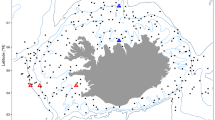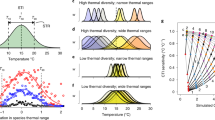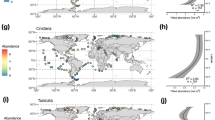Abstract
Changes in temperature, oxygen content and other ocean biogeochemical properties directly affect the ecophysiology of marine water-breathing organisms1,2,3. Previous studies suggest that the most prominent biological responses are changes in distribution4,5,6, phenology7,8 and productivity9. Both theory and empirical observations also support the hypothesis that warming and reduced oxygen will reduce body size of marine fishes10,11,12. However, the extent to which such changes would exacerbate the impacts of climate and ocean changes on global marine ecosystems remains unexplored. Here, we employ a model to examine the integrated biological responses of over 600 species of marine fishes due to changes in distribution, abundance and body size. The model has an explicit representation of ecophysiology, dispersal, distribution, and population dynamics3. We show that assemblage-averaged maximum body weight is expected to shrink by 14–24% globally from 2000 to 2050 under a high-emission scenario. About half of this shrinkage is due to change in distribution and abundance, the remainder to changes in physiology. The tropical and intermediate latitudinal areas will be heavily impacted, with an average reduction of more than 20%. Our results provide a new dimension to understanding the integrated impacts of climate change on marine ecosystems.
This is a preview of subscription content, access via your institution
Access options
Subscribe to this journal
Receive 12 print issues and online access
$209.00 per year
only $17.42 per issue
Buy this article
- Purchase on Springer Link
- Instant access to full article PDF
Prices may be subject to local taxes which are calculated during checkout



 ) and habitat temperature predicted from the growth model presented in this study (filled dots, solid line) and observations (open dots, broken line).
) and habitat temperature predicted from the growth model presented in this study (filled dots, solid line) and observations (open dots, broken line).
Similar content being viewed by others
References
Pörtner, H-O. Oxygen- and capacity-limitation of thermal tolerance: A matrix for integrating climate-related stressor effects in marine ecosystems. J. Exp. Biol. 213, 881–893 (2010).
Pauly, D. Gasping Fish and Panting Squids: Oxygen, Temperature and the Growth of Water-Breathing Animals (International Ecology Institute, 2010).
Cheung, W. W. L., Dunne, J., Sarmiento, J. L. & Pauly, D. Integrating ecophysiology and plankton dynamics into projected maximum fisheries catch potential under climate change in the Northeast Atlantic. ICES J. Mar. Sci. 68, 1008–1018 (2011).
Perry, A. L., Low, P. J., Ellis, J. R. & Reynolds, J. D. Climate change and distribution shifts in marine fishes. Science 308, 1912–1915 (2005).
Dulvy, N. K. et al. Climate change and deepening of the North Sea fish assemblage: A biotic indicator of warming seas. J. Appl. Ecol. 45, 1029–1039 (2008).
Cheung, W. W. L. et al. Projecting global marine biodiversity impacts under climate change scenarios. Fish Fisheries 10, 235–251 (2009).
Edwards, M. & Richardson, A. J. Impact of climate change on marine pelagic phenology and trophic mismatch. Nature 430, 881–884 (2004).
Genner, M. J. et al. Temperature-driven phenological changes within a marine larval fish assemblage. J. Plankton Res. 32, 699–708 (2010).
Cheung, W. W. L. et al. Large-scale redistribution of maximum fisheries catch potential in the global ocean under climate change. Glob. Change Biol. 16, 24–35 (2010).
Daufresne, M., Lengfellner, K. & Sommer, U. Global warming benefits the small in aquatic ecosystems. Proc. Natl Acad. Sci. USA 106, 12788–12793 (2009).
Baudron, A. R., Needle, C. L. & Marshall, C. T. Implications of a warming North Sea for the growth of haddock Melanogrammus aeglefinus. J. Fish Biol. 78, 1874–1889 (2011).
Sheridan, J. A. & Bickford, D. Shrinking body size as an ecological response to climate change. Nature Clim. Change 1, 401–406 (2011).
Sunday, J. M., Bates, A. E. & Dulvy, N. K. Global analysis of thermal tolerance and latitude in ectotherms. Proc. R. Soc. B 278, 1823–1830 (2011).
Verberk, W. C. E. P. & Bilton, D. T. Can oxygen set thermal limits in an insect and drive gigantism? PLoS ONE 6, e22610 (2011).
Von Bertalanffy, L. Theoretische Biologie—Zweiter Band: Stoffwechsel, Wachstum (A. Francke, 1951).
Cheung, W. W. L., Close, C., Lam, V., Watson, R. & Pauly, D. Application of macroecological theory to predict effects of climate change on global fisheries potential. Mar. Ecol. Prog. Ser. 365, 187–197 (2008).
Frölicher, T. L., Joos, F., Plattner, G. K., Steinacher, M. & Doney, S. C. Natural variability and anthropogenic trends in oceanic oxygen in a coupled carbon cycle in a coupled carbon cycle–climate model ensemble. Glob. Biogeochem. Cycles 23, GB1003 (2009).
Jeppesen, E. et al. Impacts of climate warming on lake fish community structure and potential effects on ecosystem function. Hydrobiologia 646, 73–90 (2010).
Harley, C. D. G. Climate change, keystone predation, and biodiversity loss. Science 334, 1124–1127 (2011).
Barnes, C., Maxwell, D., Reuman, D. C. & Jennings, S. Global patterns in predator–prey size relationships reveal size dependency of trophic transfer efficiency. Ecology 91, 222–232 (2010).
Floeter, J. & Temming, A. Explaining diet composition of North Sea cod (Gadus morhua): Prey size preference vs. prey availability. Can. J. Fish. Aquat. Sci. 60, 140–150 (2003).
Pauly, D. A mechanism for the juvenile-to-adult transition in fishes. ICES J. Mar. Sci. 41, 280–284 (1984).
Pauly, D. On the interrelationships between natural mortality, growth parameters and mean environmental temperature in 175 fish stocks. ICES J. Mar. Sci. 39, 175–192 (1980).
Palomares, M. L. D. & Pauly, D. Predicting food consumption of fish populations as functions of mortality, food type, morphometrics, temperature and salinity. Mar. Freshwat. Res. 49, 447–453 (1998).
Jennings, S., Kaiser, M. J. & Reynold, J. D. Marine Fisheries Ecology (Blackwell, 2001).
Dillon, M. E., Wang, G. & Huey, R. B. Global metabolic impacts of recent climate warming. Nature 467, 704–706 (2010).
Crain, C. M., Kroeker, K. & Halpern, B. S. Interactive and cumulative effects of multiple human stressors in marine systems. Ecol. Lett. 11, 1304–1315 (2008).
Taylor, C. C. Cod growth and temperature. ICES J. Mar. Sci. 23, 366–370 (1958).
Wohlschlag, D. E. in Biology of the Antarctic Seas (ed. Lee, M. O.) 33–62 (Anatarctic Research Series 1, American Geophysics Union, 1964).
Henry, K. A. Atlantic Menhaden (Brevoortia tyrannus). Resource and Fishery–Analysis of Decline. Technical Report NMFS SSRF-642 (NOAA, 1971).
Acknowledgements
The contribution by W.W.L.C. is supported by the National Geographic Society and the Centre for Environment, Fisheries and Aquaculture Sciences (CEFAS). D.P. and R.W. are supported by the Pew Charitable Trust through the Sea Around Us project. J.L.S. and T.L.F. are supported by the Carbon Mitigation Initiative (CMI) project at Princeton University, sponsored by BP. We thank L. Bopp for providing outputs from the IPSL-CM4-LOOP model.
Author information
Authors and Affiliations
Contributions
W.W.L.C. and D.P. designed the study. W.W.L.C. conducted the analysis and wrote the manuscript. J.L.S., J.D. and T.L.F. provided and prepared the outputs from the Earth System Models. R.W. provided the global catch data. V.W.Y.L. prepared the current species distributions. M.L.D.P. extracted the distributional and growth parameters from FishBase. All authors reviewed and commented on the manuscript.
Corresponding author
Ethics declarations
Competing interests
The authors declare no competing financial interests.
Supplementary information
Supplementary Information
Supplementary Information (PDF 2633 kb)
Rights and permissions
About this article
Cite this article
Cheung, W., Sarmiento, J., Dunne, J. et al. Shrinking of fishes exacerbates impacts of global ocean changes on marine ecosystems. Nature Clim Change 3, 254–258 (2013). https://doi.org/10.1038/nclimate1691
Received:
Accepted:
Published:
Issue Date:
DOI: https://doi.org/10.1038/nclimate1691
This article is cited by
-
Irreversible loss in marine ecosystem habitability after a temperature overshoot
Communications Earth & Environment (2023)
-
Gill surface area allometry does not constrain the body mass scaling of maximum oxygen uptake rate in the tidepool sculpin, Oligocottus maculosus
Journal of Comparative Physiology B (2023)
-
Exploring vulnerabilities of inland fisheries in Indian context with special reference to climate change and their mitigation and adaptation: a review
International Journal of Biometeorology (2023)
-
Assessing multi-scale vulnerability of fisheries of Vembanad lake, Peninsular India, due to climate change: a stakeholders-based approach
Environment, Development and Sustainability (2023)
-
Recent marine heatwaves in the North Pacific warming pool can be attributed to rising atmospheric levels of greenhouse gases
Communications Earth & Environment (2022)



